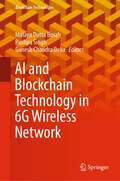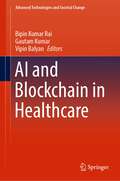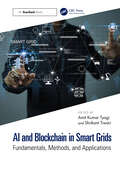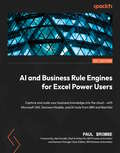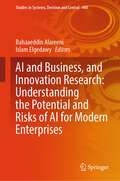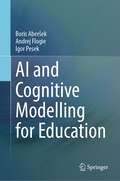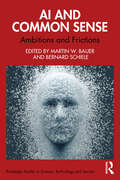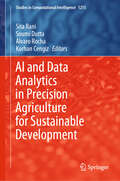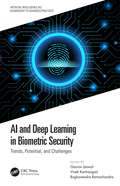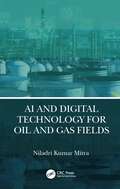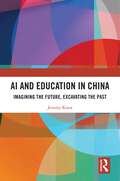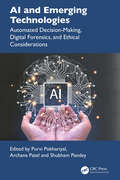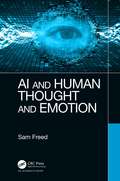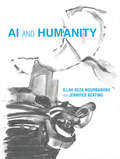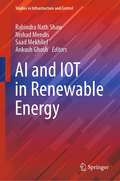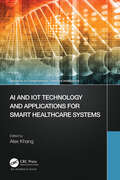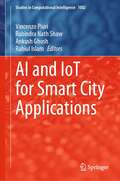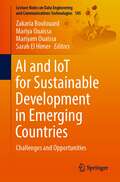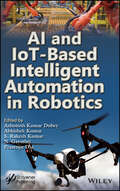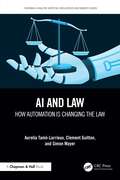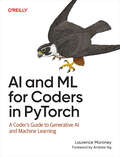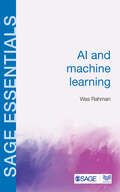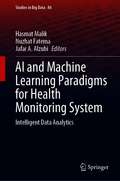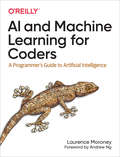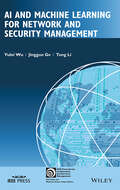- Table View
- List View
AI and Blockchain Technology in 6G Wireless Network (Blockchain Technologies)
by Ganesh Chandra Deka Malaya Dutta Borah Pushpa SinghThis book highlights future research directions and latent solutions by integrating AI and Blockchain 6G networks, comprising computation efficiency, algorithms robustness, hardware development and energy management. This book brings together leading researchers in Academia and industry from diverse backgrounds to deliver to the technical community an outline of emerging technologies, advanced architectures, challenges, open issues and future directions of 6G networks. This book is written for researchers, professionals and students to learn about the integration of technologies such as AI and Blockchain into 6G network and communications. This book addresses the topics such as consensus protocol, architecture, intelligent dynamic resource management, security and privacy in 6G to integrate AI and Blockchain and new real-time application with further research opportunities.
AI and Blockchain in Healthcare (Advanced Technologies and Societal Change)
by Gautam Kumar Bipin Kumar Rai Vipin BalyanThis book presents state-of-the-art blockchain and AI advances in health care. Healthcare service is increasingly creating the scope for blockchain and AI applications to enter the biomedical and healthcare world. Today, blockchain, AI, ML, and deep learning are affecting every domain. Through its cutting-edge applications, AI and ML are helping transform the healthcare industry for the better. Blockchain is a decentralization communication platform that has the potential to decentralize the way we store data and manage information. Blockchain technology has potential to reduce the role of middleman, one of the most important regulatory actors in our society. Transactions are simultaneously secure and trustworthy due to the use of cryptographic principles. In recent years, blockchain technology has become very trendy and has penetrated different domains, mostly due to the popularity of cryptocurrencies. One field where blockchain technology has tremendous potential is health care, due to the need for a more patient-centric approach in healthcare systems to connect disparate systems and to increase the accuracy of electronic healthcare records (EHRs).
AI and Blockchain in Smart Grids: Fundamentals, Methods, and Applications
by Amit Kumar Tyagi Shrikant TiwariAI and Blockchain in Smart Grids: Fundamentals, Methods, and Applications examines the cutting-edge solution that combines artificial intelligence (AI), blockchain technology, and digital twin concepts to innovate the management and optimization of electrical power distribution. This innovative approach enhances the resilience, efficiency, and security of electricity grids while providing real-time insights for grid operators and stakeholders. The book covers such key elements as using: Digital twins in smart grids to gather real-time data from various grid components AI-powered analytics to process the data generated by digital twins and to analyze this information to detect patterns, predict grid failures, and recommend adjustments to enhance a grid's performance Blockchain-based security to ensure the secure and transparent management of data within a smart grid, especially a tamper-resistant ledger to store information related to energy production, distribution, and consumption Decentralized data sharing to allow grid data to be shared securely among various stakeholders, including utilities, regulators, and consumers Grid optimization techniques to improve electricity distribution, reduce energy waste, and balance supply and demand efficiently Select real-world case studies and practical examples demonstrate how AI and blockchain are currently being applied to enhance grid management, energy distribution, and sustainability. By explaining to researchers, academics, and students how AI and blockchain can revolutionize electricity distribution and make grids smarter, more secure, and environmentally friendly, the book points to a future where grid operators, regulators, and consumers will benefit from real-time data and a resilient, efficient energy ecosystem.
AI and Business Rule Engines for Excel Power Users: Capture and scale your business knowledge into the cloud – with Microsoft 365, Decision Models, and AI tools from IBM and Red Hat
by Paul Browne Alex PorcelliA power-packed manual to enhance your decision-making with the application of Business Rules using KIE, Drools, Kogito, MS Excel, Power Automate, Office Script, and MS FormsPurchase of the print or Kindle book includes a free PDF eBookKey FeaturesExplore the business rule tools by implementing real-world examples to write sophisticated rulesDiscover how decision services solve current business challenges using AICombine rules with workflows and scripting to deploy a cloud-based production environmentBook DescriptionMicrosoft Excel is widely adopted across diverse industries, but Excel Power Users often encounter limitations such as complex formulas, obscure business knowledge, and errors from using outdated sheets. They need a better enterprise-level solution, and this book introduces Business rules combined with the power of AI to tackle the limitations of Excel.This guide will give you a roadmap to link KIE (an industry-standard open-source application) to Microsoft's business process automation tools, such as Power Automate, Power Query, Office Script, Forms, VBA, Script Lab, and GitHub. You'll dive into the graphical Decision Modeling standard including decision tables, FEEL expressions, and advanced business rule editing and testing.By the end of the book, you'll be able to share your business knowledge as graphical models, deploy and execute these models in the cloud (with Azure and OpenShift), link them back to Excel, and then execute them as an end-to-end solution removing human intervention. You'll be equipped to solve your Excel queries and start using the next generation of Microsoft Office tools.What you will learnUse KIE and Drools decision services to write AI-based business rulesLink Business Rules to Excel using Power Query, Script Lab, Office Script, and VBABuild an end-to-end workflow with Microsoft Power Automate and Forms while integrating it with Excel and KogitoCollaborate on and deploy your decision models using OpenShift, Azure, and GitHubDiscover advanced editing using the graphical Decision Model Notation (DMN) and testing toolsUse Kogito to combine AI solutions with ExcelWho this book is forThis book is for Excel power users, business users, and business analysts looking for a tool to capture their knowledge and deploy it as part of enterprise-grade systems. Working proficiency with MS Excel is required. Basic knowledge of web technologies and scripting would be an added advantage.
AI and Business, and Innovation Research: Understanding the Potential and Risks of AI for Modern Enterprises (Studies in Systems, Decision and Control #440)
by Islam Elgedawy Bahaaeddin AlareeniThis book provides a comprehensive overview of the latest trends and developments in AI and business innovation research. In today's rapidly changing business environment, artificial intelligence (AI) has become an essential tool for innovation and growth. From marketing and customer service to supply chain management and product development, AI is transforming the way businesses operate, allowing them to make better decisions and achieve their goals faster and more efficiently than ever before.However, the integration of AI into business operations is not without its challenges and risks. There are concerns about data privacy, cybersecurity, and the potential for AI to disrupt traditional industries and displace workers. As a result, it is essential for business leaders and researchers to understand both the potential and risks of AI, and how it can be effectively leveraged for business innovation.This book explores the potential benefits of AI for modern enterprises, including how it can be used to enhance customer service, optimize supply chain management, and improve decision-making in a range of business contexts. It also examines the role of AI in product development, marketing, and sales, and how it can be used to drive innovation and growth.The book also examines the risks and challenges associated with the integration of AI into business operations. It explores the ethical and legal implications of AI, including issues related to data privacy and security, bias in algorithms, and the impact of AI on employment and the labor market. It also examines the role of government and policymakers in regulating AI and managing the risks associated with its integration into business operations.Overall, this book provides a comprehensive and balanced perspective on the potential and risks of AI for modern enterprises.
AI and Cognitive Modelling for Education
by Boris Aberšek Andrej Flogie Igor PesekThis book offers a groundbreaking approach to bridging the gap between various disciplines involved in cognitive modeling in education. By drawing on the fields of learning, neuro science, cognitive science, neurobiology, and computer science, it provides a new perspective on how we can integrate these disciplines with education to create more effective learning environments. The main objective of this book is to delve into the ethical, sociological, and technological questions surrounding the introduction of intelligent and smart learning environments in education. By analyzing these issues, this book aims to bridge the gap between the various disciplines involved in cognitive modeling and education, while highlighting the benefits and risks associated with these advancements. With the emergence of AI-based tutors, coaches, and learning environments, students now have access to a new type of self-learning and self-training that was previously unavailable. Distance learning has become increasingly popular in recent years, and the use of computer-assisted learning tools has revolutionized the way we think about education. The goal of education must be to instill in students a desire to learn for themselves, and this can only be achieved through active, self-directed, and reflective learning. With intelligent tutoring systems, students are empowered to take an active role in their own education, rather than simply being passive recipients of information. This book offers practical strategies for teachers to facilitate this transition, enabling them to act as facilitators and guides rather than one-way communicators. By embracing this new approach to education, we can help students become lifelong learners who are equipped with the skills they need to succeed in the 21st century. As we cannot predict the future with certainty, the true effects of education may only be revealed in the long run, making it critical to understand the potential consequences of introducing these new learning tools. By exploring these complex topics, this book offers valuable insights for educators, policymakers, and anyone interested in the future of education.
AI and Common Sense: Ambitions and Frictions (Routledge Studies in Science, Technology and Society)
by Martin W. Bauer and Bernard SchieleCommon sense is the endless frontier in the development of artificial intelligence, but what exactly is common sense, can we replicate it in algorithmic form, and if we can – should we?Bauer, Schiele and their contributors from a range of disciplines analyse the nature of common sense, and the consequent challenges of incorporating into artificial intelligence models. They look at different ways we might understand common sense and which of these ways are simulated within computer algorithms. These include sensory integration, self-evident truths, rhetorical common places, and mutuality and intentionality of actors within a moral community. How far are these possible features within and of machines? Approaching from a range of perspectives including Sociology, Political Science, Media and Culture, Psychology and Computer Science, the contributors lay out key questions, practical challenges and "common sense" concerns underlying the incorporation of common sense within machine learning algorithms for simulating intelligence, socialising robots, self-driving vehicles, personnel selection, reading, automatic text analysis, and text production.A valuable resource for students and scholars of Science–Technology–Society Studies, Sociologists, Psychologists, Media and Culture Studies, human–computer interaction with an interest in the post-human, and programmers tackling the contextual questions of machine learning.
AI and Data Analytics in Precision Agriculture for Sustainable Development (Studies in Computational Intelligence #1215)
by Álvaro Rocha Soumi Dutta Korhan Cengiz Sita RaniThis book offers a comprehensive analysis of artificial intelligence (AI) and data analytics in precision agriculture. The integration of technology in agriculture is revolutionizing traditional farming practices, paving the way for sustainability. Precision farming, powered by AI, IoT, and big data, optimizes resource use by enabling real-time monitoring of soil health, weather conditions, and crop growth. Automated irrigation systems and drones reduce water wastage and enhance productivity. Biotechnology advances, such as genetically modified crops and CRISPR gene editing, improve yield, pest resistance, and climate adaptability. Vertical farming and hydroponics offer space-efficient solutions, minimizing land degradation and water consumption. Robotics and autonomous machinery streamline labor-intensive tasks, reducing reliance on chemical inputs. Blockchain ensures transparency in the food supply chain, promoting fair trade and reducing food fraud. Renewable energy sources, like solar-powered farms, further lower agriculture&’s carbon footprint. By adopting these innovations, farmers can produce more with fewer resources, ensuring food security while preserving the environment. Embracing technology-driven agriculture is crucial for meeting global food demands sustainably, combating climate change, and fostering economic resilience in farming communities. The future of agriculture lies in intelligent, data-driven, and eco-friendly solutions that balance productivity with environmental stewardship.
AI and Deep Learning in Biometric Security: Trends, Potential, and Challenges (Artificial Intelligence (AI): Elementary to Advanced Practices)
by Gaurav Jaswal Vivek KanhangadThis book provides an in-depth overview of artificial intelligence and deep learning approaches with case studies to solve problems associated with biometric security such as authentication, indexing, template protection, spoofing attack detection, ROI detection, gender classification etc. This text highlights a showcase of cutting-edge research on the use of convolution neural networks, autoencoders, recurrent convolutional neural networks in face, hand, iris, gait, fingerprint, vein, and medical biometric traits. It also provides a step-by-step guide to understanding deep learning concepts for biometrics authentication approaches and presents an analysis of biometric images under various environmental conditions. This book is sure to catch the attention of scholars, researchers, practitioners, and technology aspirants who are willing to research in the field of AI and biometric security.
AI and Digital Technology for Oil and Gas Fields
by Niladri Kumar MitraThe book essentially covers the growing role of AI in the oil and gas industry, including digital technologies used in the exploration phase, customer sales service, and cloud-based digital storage of reservoir simulation data for modeling. It starts with the description of AI systems and their roles within the oil and gas industry, including the agent-based system, the impact of industrial IoT on business models, and the ethics of robotics in AI implementation. It discusses incorporating AI into operations, leading to the reduction of operating costs by localizing control functions, remote monitoring, and supervision.Features of this book are given as follows: It is an exclusive title on the application of AI and digital technology in the oil and gas industry It explains cloud data management in reservoir simulation It discusses intelligent oil and gas well completion in detail It covers marketing aspects of oil and gas business during the exploration phase It reviews development of digital systems for business purposes This book is aimed at professionals in petroleum and chemical engineering, technology, and engineering management.
AI and Education in China: Imagining the Future, Excavating the Past
by Jeremy KnoxThis book explores the relationships between artificial intelligence (AI) and education in China. It examines educational activity in the context of profound technological interventions, far-reaching national policy, and multifaceted cultural settings. By standing at the intersection of three foundational topics – AI and the recent proliferation of data-driven technologies; education, the most foundational of our social institutions in terms of actively shaping societies and individuals; and, finally, China, which is a frequent subject for dramatic media reports about both technology and education – this book offers an insightful view of the contexts that underpin the use of AI in education, and promotes a more in-depth understanding of China. Scholars of educational technology and digital education will find this book an indispensable guide to the ways new technologies are imagined to transform the future, while being firmly grounded in the past.
AI and Emerging Technologies: Automated Decision-Making, Digital Forensics, and Ethical Considerations
by Archana Patel Purvi Pokhariyal Shubham PandeyIn the past decade, Artificial Intelligence (AI) has made significant advancements in various sectors of society, such as education, health, e-commerce, media and entertainment, banking and finance, transportation, and defense, among others. Its application has permeated every sector, leaving no area untouched. However, the utilization of AI brings forth crucial legal, ethical, and technical concerns and obstacles that must be appropriately addressed through thoughtful deliberation, discussions, and the implementation of effective regulations.AI and Emerging Technologies: Automated Decision-Making, Digital Forensics, and Ethical Considerations provides a comprehensive and insightful roadmap for exploring the advancements, challenges, solutions, and implications of AI in three key areas: the legal field, gaming applications, digital forensic, and decision-making. By delving into these topics, this book offers a deep understanding of how AI can be optimally utilized to deliver maximum benefits to users, all within a single, comprehensive source. One of the focuses of this book is to shed light on the preictal application of emerging technologies in automated decision-making while also addressing the ethical considerations that arise from their use. By examining the integration of these technologies into digital forensics and their impact on other domains, such as gaming applications deep fake, this book presents valuable insights into the broader implications of AI.The book serves as an invaluable resource for anyone seeking to understand and navigate the complex world of AI. By offering a comprehensive exploration of its applications, ethical considerations, and data protection techniques, it provides researchers and scholars, graduate students, software engineers along with data scientists the necessary insights to harness the full potential of AI while ensuring its responsible and ethical use.
AI and Human Thought and Emotion
by Sam FreedThe field of artificial intelligence (AI) has grown dramatically in recent decades from niche expert systems to the current myriad of deep machine learning applications that include personal assistants, natural-language interfaces, and medical, financial, and traffic management systems. This boom in AI engineering masks the fact that all current AI systems are based on two fundamental ideas: mathematics (logic and statistics, from the 19th century), and a grossly simplified understanding of biology (mainly neurons, as understood in 1943). This book explores other fundamental ideas that have the potential to make AI more anthropomorphic. Most books on AI are technical and do not consider the humanities. Most books in the humanities treat technology in a similar manner. AI and Human Thought and Emotion, however is about AI, how academics, researchers, scientists, and practitioners came to think about AI the way they do, and how they can think about it afresh with a humanities-based perspective. The book walks a middle line to share insights between the humanities and technology. It starts with philosophy and the history of ideas and goes all the way to usable algorithms. Central to this work are the concepts of introspection, which is how consciousness is viewed, and consciousness, which is accessible to humans as they reflect on their own experience. The main argument of this book is that AI based on introspection and emotion can produce more human-like AI. To discover the connections among emotion, introspection, and AI, the book travels far from technology into the humanities and then returns with concrete examples of new algorithms. At times philosophical, historical, and technical, this exploration of human emotion and thinking poses questions and provides answers about the future of AI.
AI and Humanity (The\mit Press Ser.)
by Illah Reza Nourbakhsh Jennifer KeatingAn examination of the implications for society of rapidly advancing artificial intelligence systems, combining a humanities perspective with technical analysis; includes exercises and discussion questions.AI and Humanity provides an analytical framing and a common language for understanding the effects of technological advances in artificial intelligence on society. Coauthored by a computer scientist and a scholar of literature and cultural studies, it is unique in combining a humanities perspective with technical analysis, using the tools of literary explication to examine the societal impact of AI systems. It explores the historical development of these technologies, moving from the apparently benign Roomba to the considerably more sinister semi-autonomous weapon system Harpy. The book is driven by an exploration of the cultural and etymological roots of a series of keywords relevant to both AI and society. Works examined range from Narrative of the Life of Frederick Douglass, given a close reading for its themes of literacy and agency, to Simon Head's critique of the effects of surveillance and automation on the Amazon labor force in Mindless.Originally developed as a textbook for an interdisciplinary humanities-science course at Carnegie Mellon, AI & Humanity offers discussion questions, exercises (including journal writing and concept mapping), and reading lists. A companion website provides updated resources and a portal to a video archive of interviews with AI scientists, sociologists, literary theorists, and others.
AI and IOT in Renewable Energy (Studies in Infrastructure and Control)
by Saad Mekhilef Ankush Ghosh Rabindra Nath Shaw Nishad MendisThis book presents the latest research on applications of artificial intelligence and the Internet of Things in renewable energy systems. Advanced renewable energy systems must necessarily involve the latest technology like artificial intelligence and Internet of Things to develop low cost, smart and efficient solutions. Intelligence allows the system to optimize the power, thereby making it a power efficient system; whereas, Internet of Things makes the system independent of wire and flexibility in operation. As a result, intelligent and IOT paradigms are finding increasing applications in the study of renewable energy systems. This book presents advanced applications of artificial intelligence and the internet of things in renewable energy systems development. It covers such topics as solar energy systems, electric vehicles etc. In all these areas applications of artificial intelligence methods such as artificial neural networks, genetic algorithms, fuzzy logic and a combination of the above, called hybrid systems, are included. The book is intended for a wide audience ranging from the undergraduate level up to the research academic and industrial communities engaged in the study and performance prediction of renewable energy systems.
AI and IoT Technology and Applications for Smart Healthcare Systems (Advances in Computational Collective Intelligence)
by Alex KhangIn recent years, the application of Artificial Intelligence (AI) and Internet of Things (IoT) technologies in smart healthcare has been increasing. We are approaching a world where connected smart devices tell people when they need to visit a doctor because these devices will be able to detect health problems and discover symptoms of illness that may need medical care. AI-collaborative IoT technologies can help medical professionals with decision-making. These technologies can also help develop a sustainable and smart healthcare system.AI and IoT Technology and Applications for Smart Healthcare Systems helps readers understand complex scientific topics in a simple and accessible way. It introduces the world of AI-collaborative IoT physics, explaining how this technology behaves at the smallest level and how this can revolutionize healthcare. The book shows how IoT technology and AI can work together to make computers more powerful and capable of solving complex problems in the healthcare sector. Exploring the effect of AI-collaborative technology on IoT technologies, the book discusses how IoT can benefit from AI algorithms to enable machines to learn, make decisions, and process information more efficiently. Because smart machines create more perceptive devices and systems, the application of this technology raises important ethical questions about privacy, security, and the responsible development of healthcare IoT technology, which this book covers. The book also provides insight into the potential applications of these technologies not only in the healthcare industry but also in related fields, such as smart transportation, smart manufacturing, and smart cities.
AI and IoT for Smart City Applications (Studies in Computational Intelligence #1002)
by Vincenzo Piuri Rabiul Islam Ankush Ghosh Rabindra Nath ShawThis book provides a valuable combination of relevant research works on developing smart city ecosystem from the artificial intelligence (AI) and Internet of things (IoT) perspective. The technical research works presented here are focused on a number of aspects of smart cities: smart mobility, smart living, smart environment, smart citizens, smart government, and smart waste management systems as well as related technologies and concepts. This edited book offers critical insight to the key underlying research themes within smart cities, highlighting the limitations of current developments and potential future directions.
AI and IoT for Sustainable Development in Emerging Countries: Challenges and Opportunities (Lecture Notes on Data Engineering and Communications Technologies #105)
by Mariya Ouaissa Zakaria Boulouard Mariyam Ouaissa Sarah El HimerThis book comprises a number of state-of-the-art contributions from both scientists and practitioners working in a large pool of fields where AI and IoT can open up new horizons. Artificial intelligence and Internet of Things have introduced themselves today as must-have technologies in almost every sector. Ranging from agriculture to industry and health care, the scope of applications of AI and IoT is as wide as the horizon. Nowadays, these technologies are extensively used in developed countries, but they are still at an early stage in emerging countries. AI and IoT for Sustainable Development in Emerging Countries—Challenges and Opportunities is an invaluable source to dive into the latest applications of AI and IoT and how they have been used by researchers from emerging countries to solve sustainable development-related issues by taking into consideration the specifities of their countries. This book starts by presenting how AI and IoT can tackle the challenges of sustainable development in general and then focuses on the following axes: · AI and IoT for smart environment and energy · Industry 4.0 and intelligent transportation · A vision towards an artificial intelligence of medical things · AI, social media, and big data analytics. It aspires to provide a relevant reference for students, researchers, engineers, and professionals working in these particular areas or those interested in grasping its diverse facets and exploring the latest advances on their respective fields and the role of AI and IoT in them.
AI and IoT-Based Intelligent Automation in Robotics
by Abhishek Kumar Ashutosh Kumar Dubey N. Gayathri S. Rakesh Kumar Prasenjit DasThe 24 chapters in this book provides a deep overview of robotics and the application of AI and IoT in robotics. It contains the exploration of AI and IoT based intelligent automation in robotics. The various algorithms and frameworks for robotics based on AI and IoT are presented, analyzed, and discussed. This book also provides insights on application of robotics in education, healthcare, defense and many other fields which utilize IoT and AI. It also introduces the idea of smart cities using robotics.
AI and Law: How Automation is Changing the Law (Chapman & Hall/CRC Artificial Intelligence and Robotics Series)
by Aurelia Tamo-Larrieux Clement Guitton Simon MayerThis book provides insights into how AI is changing legal practice, government processes, and individuals’ access to those processes, encouraging each of us to consider how technological advances are changing the legal system. Particularly, and distinct from current debates on how to regulate AI, this books focuses on how the progressive merger between computational methods and legal rules changes the very structure and application of the law itself.We investigate how automation is changing the legal analysis, legal rulemaking, legal rule extraction, and application of legal rules and how this impacts individuals, policymakers, civil servants, and society at large. We show through many examples that a debate on how automation is changing the law is needed, which must revolve around the democratic legitimacy of the automation of legal processes, and be informed by the technical feasibility and tradeoffs of specific endeavors.
AI and ML for Coders in PyTorch
by Laurence MoroneyEager to learn AI and machine learning but unsure where to start? Laurence Moroney's hands-on, code-first guide demystifies complex AI concepts without relying on advanced mathematics. Designed for programmers, it focuses on practical applications using PyTorch, helping you build real-world models without feeling overwhelmed.From computer vision and natural language processing (NLP) to generative AI with Hugging Face Transformers, this book equips you with the skills most in demand for AI development today. You'll also learn how to deploy your models across the web and cloud confidently.Gain the confidence to apply AI without needing advanced math or theory expertiseDiscover how to build AI models for computer vision, NLP, and sequence modeling with PyTorchLearn generative AI techniques with Hugging Face Diffusers and Transformers
AI and Machine Learning (SAGE Essentials)
by Was RahmanWas Rahman′s AI and Machine Learning achieves that rare balance of making a difficult and complex topic accessible to non-specialists, without dumbing down. He starts with an enlightening and entertaining explanation of what artificial intelligence (AI) is and how it works. This includes often-overlooked fundamentals like what we actually mean by ′intelligence′, artificial or otherwise. Rahman brings his explanations to life with lucid and, at times, surprising examples of AI already in use around us. He takes these back to first principles, deftly avoiding any need to understand the maths or computing involved. This allows him to demystify what the technology is really doing and show us that much of it is reassuringly mundane, despite the hype. This distinctive approach comes into its own when examining the challenges and risks of AI. It allows the author to remove the drama and fear of sensationalized headlines and doom-laden movie plots. In their place, he offers an insightful analysis of how the major issues surface, what options we have for addressing them and why some dilemmas may prove intractable. A must-read to understand the reality and implications of AI beyond the hype!
AI and Machine Learning Paradigms for Health Monitoring System: Intelligent Data Analytics (Studies in Big Data #86)
by Jafar A. Alzubi Hasmat Malik Nuzhat FatemaThis book embodies principles and applications of advanced soft computing approaches in engineering, healthcare and allied domains directed toward the researchers aspiring to learn and apply intelligent data analytics techniques. The first part covers AI, machine learning and data analytics tools and techniques and their applications to the class of several hospital and health real-life problems. In the later part, the applications of AI, ML and data analytics shall be covered over the wide variety of applications in hospital, health, engineering and/or applied sciences such as the clinical services, medical image analysis, management support, quality analysis, bioinformatics, device analysis and operations. The book presents knowledge of experts in the form of chapters with the objective to introduce the theme of intelligent data analytics and discusses associated theoretical applications. At last, it presents simulation codes for the problems included in the book for better understanding for beginners.
AI and Machine Learning for Coders: A Programmer's Guide To Artificial Intelligence
by Laurence MoroneyIf you're looking to make a career move from programmer to AI specialist, this is the ideal place to start. Based on Laurence Moroney's extremely successful AI courses, this introductory book provides a hands-on, code-first approach to help you build confidence while you learn key topics.You'll understand how to implement the most common scenarios in machine learning, such as computer vision, natural language processing (NLP), and sequence modeling for web, mobile, cloud, and embedded runtimes. Most books on machine learning begin with a daunting amount of advanced math. This guide is built on practical lessons that let you work directly with the code.You'll learn:How to build models with TensorFlow using skills that employers desireThe basics of machine learning by working with code samplesHow to implement computer vision, including feature detection in imagesHow to use NLP to tokenize and sequence words and sentencesMethods for embedding models in Android and iOSHow to serve models over the web and in the cloud with TensorFlow Serving
AI and Machine Learning for Network and Security Management (IEEE Press Series on Networks and Service Management)
by Yulei Wu Tong Li Jingguo GeAI AND MACHINE LEARNING FOR NETWORK AND SECURITY MANAGEMENT Extensive Resource for Understanding Key Tasks of Network and Security Management AI and Machine Learning for Network and Security Management covers a range of key topics of network automation for network and security management, including resource allocation and scheduling, network planning and routing, encrypted traffic classification, anomaly detection, and security operations. In addition, the authors introduce their large-scale intelligent network management and operation system and elaborate on how the aforementioned areas can be integrated into this system, plus how the network service can benefit. Sample ideas covered in this thought-provoking work include: How cognitive means, e.g., knowledge transfer, can help with network and security management How different advanced AI and machine learning techniques can be useful and helpful to facilitate network automation How the introduced techniques can be applied to many other related network and security management tasks Network engineers, content service providers, and cybersecurity service providers can use AI and Machine Learning for Network and Security Management to make better and more informed decisions in their areas of specialization. Students in a variety of related study programs will also derive value from the work by gaining a base understanding of historical foundational knowledge and seeing the key recent developments that have been made in the field.
